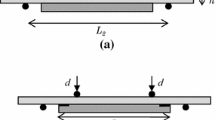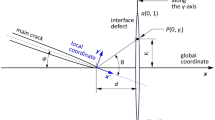Abstract
In this paper, we studied the interface debonding when a crack perpendicularly approaches an interface between two dissimilar elastic materials. An interface toughness law was first defined according to an adhesive model governing the interface fracture. By analysing the interaction between the normally approaching crack and the interface crack and by tacking account of the adhesive forces at ends of the interfacial crack, a model for studying the interface debonding and the debonding stability was established. It is observed that the interface debonding toughness depends strongly on the mixed mode locally produced over the plastic adhesive zone of the interface. Moreover, the interface debonding may be unstable, i.e. the interface debonding length may jump from an initial value to a certain final value under critical remote loading. This jump may be surprisedly important in certain cases. These results agree with the experimental works gathered so far and can be used to explain the mechanism of 'crack arrestor' formed by an interface.
Similar content being viewed by others
References
Barenblatt, G.I. (1959). On the equilibrium cracks dues to brittle fracture. Straight-line cracks in flat plates. Journal of Applied Mathematics and Mechanics 23, 434.
Beltz, G.E. and Rice, J.R. (1991). Modeling the Deformation of Crystalline Solids (Edited by Lowe, T.C. and Rollett, A.) The Minerals, Metals and Materials Soc., TMS, Warrendale, PA, p. 457.
Cao, H.C. and Evans, A.G. (1989). An experimental study of the fracture resistance of bimaterial interfaces. Mechanics of Materials 7, 295–304.
Cook, T.S. and Erdogan, F. (1972). Stresses in bonded materials with a crack perpendicular to the interface. International Journal of Engineering Science 10, 677–697.
Dugdale, D.S. (1960). Yielding of steel sheet containing slits. Journal of Mechanics and Physics of Solids 8, 100–104.
Dundurs, J. (1969). Edge-bonded dissimilar orthogonal elastic wedges. Journal of Applied Mechanics 29, 650–652.
Erdogan, F. and Birickoglu, V. (1973). Two bonded half planes with a crack going through the interface. International Journal of Engineering Science 11, 745–766.
Erdogan, F. and Cupta, G.D. (1972). On the numerical solution of singular integral equations. Quarterly of Applied Mathematics 29, 525–534.
Evans, A.G. and Hutchinson, J.W. (1989). Effects of non-planarity on the mixed mode fracture resistance of bimaterial interfaces. Acta Metallica 37, 909–916
He, M.Y. and Hutchinson, J.W. (1989). Cracking deflection at an interface between dissimilar elastic materials. International Journal of Solids Structures 25, 1053–1067.
Hertzberg, P.W. (1976). Deformation and Fracture Mechanics of Engineering Materials, John Wiley & sons, New York.
Hutchinson, J.W. and Suo, Z.G.(1992).Mixed mode cracking in layered materials. Advances in AppliedMechanics 29, 63–191.
Liechti K.M. and Chal, Y.S. (1992). Asymmetric shielding in interfacial fracture under inplane shear. Journal of Applied Mechanics 59, 295.
Lemaitre, J., Desmorat, R., Vidonne, M.P. and Zhang, P. (1996). Reinitiation of crack reaching an interface. International Journal of Fracture 80, 257–276.
O'Dowd, N.P., Stout, M.G. and Shih, C.F. (1992). Fracture toughness of alumina/niobium interfaces: experiments and analysis. Philosophy Magazine A66, 1037.
Rice, P. (1988). Elastic fracture concepts for interfacial cracks in dissimilar media. Journal of Applied Mechanics 55, 98–103.
Suo, Z.G. (1989). Singularities interacting with interfaces and cracks. International Journal of Solids Structures 25, 1133–1142.
Thouless, M.D. (1990). Fracture of a model interface under mixed-mode loading. Acta Metallica Materials 38, 1135–1140.
Volkerson, 0. (1938). Die Nietkraftverteilung in Zugbeanspruchten mit Konstanten Laschenquerschritten. Luftahrt Forschungen 15, 41–47.
Zak, A.R. and Williams, M.L. (1963). Crack point singularities at a bi-material interface. Journal of Applied Mechanics 30, 142–138.
Author information
Authors and Affiliations
Rights and permissions
About this article
Cite this article
Li, J. Debonding of the interface as 'crack arrestor'. International Journal of Fracture 105, 57–79 (2000). https://doi.org/10.1023/A:1007603809972
Issue Date:
DOI: https://doi.org/10.1023/A:1007603809972




